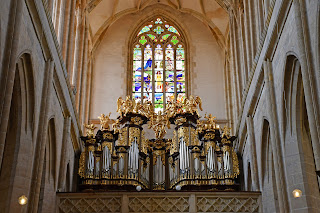East of Prague
Not long after my solo trip south of Prague, my dad took me to see Kutná Hora, a UNESCO-listed town to the east of the capital. As its name (which roughly translates to Mining Mountain) indicates, Kutná Hora gained prominence and made a fortune thanks to the discovery of silver in the thirteenth century. This fortune, in turn, enabled the financing of some truly impressive architectural projects, among them the Church of Saint Barbara (the patron saint of miners), with its three peaks and prominent pillar frame.
Perhaps the
most interesting and bizarre sight in the neighbourhood of Kutná Hora, however, is Sedlec Ossuary, a chapel
decorated with the bones of somewhere between 40,000 and 70,000 people. These
were used in the church to make all sorts of things, like a chandelier, a coat
of arms, and a monstrance. Near Sedlec Ossuary is another UNESCO-listed site, Sedlec
Abbey, the oldest Cistercian monastery in Bohemia. Obviously, we could take the
dog to neither of these, so we took turns walking it outside, waiting to be
switched out and allowed in. Nor were we permitted to take pictures inside the ossuary due to the
misbehaviour of tourists in previous years.
After this
brief excursion to Sedlec, we visited the aforementioned Church of Saint
Barbara in Kutná Hora. Although it looks quite impressive as it stands today,
the church was originally supposed to be twice as large: the funding waxed and
waned with the town’s income from mining. One interesting fact is that
construction of the church began under Johann Parler, son of Peter Parler, who
designed Saint Vitus Cathedral and Charles Bridge in Prague. Not to be missed
are the church’s expressive stained-glass windows with their dazzling
historical and floral motifs.
We followed
our visit to Saint Barbara’s Church with a brief excursion of the town proper.
Kutná Hora is a pretty, pastel-coloured
mixture of styles, remarkable for its plague column and fully preserved gothic fountain.
From the late Middle Ages until the Renaissance, the town rivalled Prague with
its wealth and splendour, becoming the second largest town in Bohemia by the
outset of the Hussite Wars.
Although Kutná
Hora was the main item on our itinerary, our route took us past quite a
few picturesque places. On the way there, we passed the Český Šternberk, a well-preserved gothic
castle that dates to the 13th century. On the way back, we visited Kolín, an important district town
with a pretty square, impressive church, and a Jewish Cemetery (which was
unfortunately closed at the time of our visit). Finally, we made short stops in
the town Český Brod and the chateaux
Dolní Břežany and Zbraslav.




















































































Comments
Post a Comment